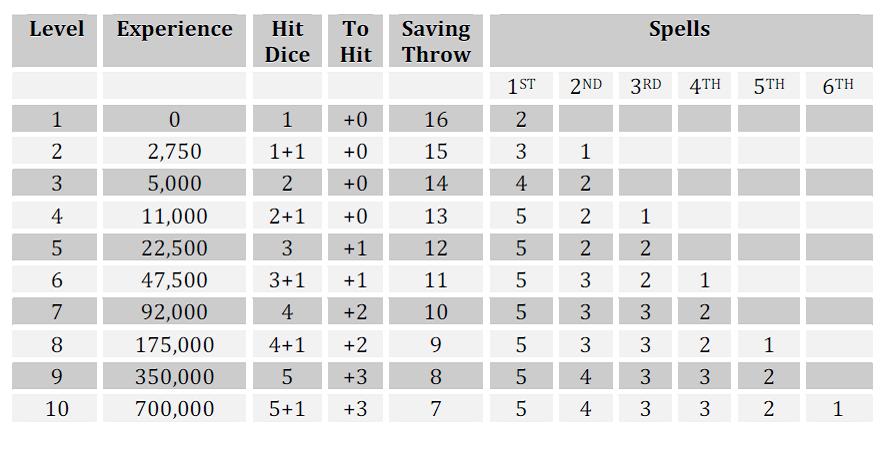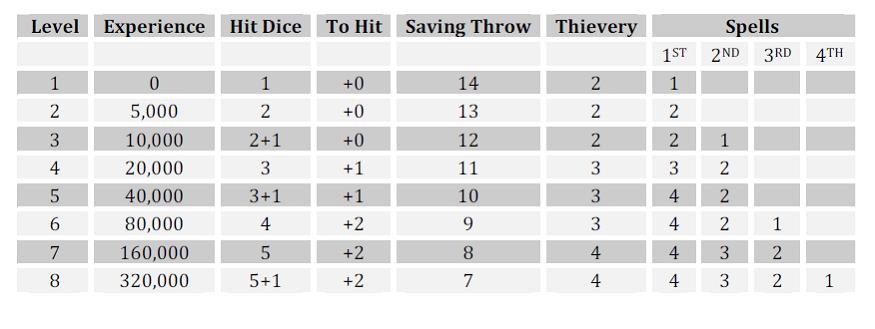THE ILLUSIONIST
Illusionists are Magic-Users who specialise in illusions and mind-control. This gives them access to more spells than ordinary Magic-Users but many of their spells can be seen through as mere illusions.
Illusionists can advance to 10th level. They can use any magic items that pertain to detection, ESP, mind control or illusions. llusionists are usually Human but at the Referee’s discretion Gnomes may also be Illusionists.
Illusionists can advance to 10th level. They can use any magic items that pertain to detection, ESP, mind control or illusions. llusionists are usually Human but at the Referee’s discretion Gnomes may also be Illusionists.
Armour & Weapon Restrictions
Illusionists may not wear armour and are limited to using daggers and staves in combat.
Spell Casting
Illusionists cast Magic-User spells but have access to more spells (they are treated as one level higher – but see Illusory Spells below). They can use all magic items usable by Magic-Users.
Illusory Spells
Many Illusionist spells work normally but some are illusory versions of the ordinary Magic-User spells:
Animate Dead, Conjure Elemental: creates an illusory monster that deals illusory damage
Control Weather: creates illusory weather conditions
Death Spell: causes illusory ‘death’ (i.e. the victim is knocked out)
Dispel Magic, Remove Curse: will only dispel illusions or mind-control
Fireball, Lightning Bolt, Cloudkill: deal illusory damage and only appear to damage objects
Hold Portal & Wizard Lock: create an illusion that the door remains intact even when it is open
Polymorph: creates an illusory change in appearance
Transform Rock, Mud, Stone or Flesh: creates an illusory transformation
Wall of Fire, Ice, Stone or Iron: creates an illusory barrier the causes illusory damage
Web: creates illusory webs that only appear to trap people
Illusions are canceled and disappear if they are touched by someone who disbelieves in them (achieved by saving vs Spells) or if the Illusionist is unconscious. Illusory side-effects (e.g. things on fire, footprints, bloodstains) last for 1d6 rounds after the illusion disappears then they fade too. Illusory damage causes a creature on 0 HP to be knocked out for 1d6 rounds. When they recover they will regain all HP lost to the illusion.
Animate Dead, Conjure Elemental: creates an illusory monster that deals illusory damage
Control Weather: creates illusory weather conditions
Death Spell: causes illusory ‘death’ (i.e. the victim is knocked out)
Dispel Magic, Remove Curse: will only dispel illusions or mind-control
Fireball, Lightning Bolt, Cloudkill: deal illusory damage and only appear to damage objects
Hold Portal & Wizard Lock: create an illusion that the door remains intact even when it is open
Polymorph: creates an illusory change in appearance
Transform Rock, Mud, Stone or Flesh: creates an illusory transformation
Wall of Fire, Ice, Stone or Iron: creates an illusory barrier the causes illusory damage
Web: creates illusory webs that only appear to trap people
Illusions are canceled and disappear if they are touched by someone who disbelieves in them (achieved by saving vs Spells) or if the Illusionist is unconscious. Illusory side-effects (e.g. things on fire, footprints, bloodstains) last for 1d6 rounds after the illusion disappears then they fade too. Illusory damage causes a creature on 0 HP to be knocked out for 1d6 rounds. When they recover they will regain all HP lost to the illusion.
Unavailable Spells
Illusionists cannot bring about real change in the world so these spells are unavailable to them:
Alter Time, Animal Growth, Dimension Door, Disintegrate, Fly, Knock, Levitate, Move Earth or Water, Passwall, Plant Growth, Reincarnation, Telekinesis, Teleport, Transform (rock, mud, flesh, stone), Water Breathing
Alter Time, Animal Growth, Dimension Door, Disintegrate, Fly, Knock, Levitate, Move Earth or Water, Passwall, Plant Growth, Reincarnation, Telekinesis, Teleport, Transform (rock, mud, flesh, stone), Water Breathing
Minor Glamour
Illusionists can alter their own appearance at will, changing dress, age, facial features, gender, height and build. They cannot appear to be a different race and something of their appearance must remain constant – normally voice, the colour of their robes, the smell of perfume or a distinctive brooch.
The Illusionist can alter the appearance of anything held in hand, although it reverts to its true appearance when they let go of it.
NB. This ability replaces the Familiar that ordinary Magic-Users may summon.
The Illusionist can alter the appearance of anything held in hand, although it reverts to its true appearance when they let go of it.
NB. This ability replaces the Familiar that ordinary Magic-Users may summon.
Saving Throws
Illusionists gain a +2 bonus against illusions or trickery.
Establish Retreat
At ninth level, an Illusionist may build a hidden retreat, often concealed by permanent illusions or on the borders of Faerie. The character may choose to attract a body of loyal apprentices and guards and may include fey creatures (Dryads, Gnomes, Sidhe) at the Referee’s discretion.
Trauma
Illusionists are crazed tricksters. They gain a point of Trauma if one of their illusory spells is disbelieved.
Illusionists do not gain Trauma from mind-controlling or illusion spells or monster powers that manipulate perceptions or emotions (including charm, fear and confusion).
Illusionists do not gain Trauma from mind-controlling or illusion spells or monster powers that manipulate perceptions or emotions (including charm, fear and confusion).
Illusionist Feats
Illusionists may choose from these Feats instead of the normal Magic-User Feats:
- Charming Mien: Your Glamour can add +2 to your Charisma
- Convincing Illusions: -3 to saving throws to disbelieve your illusions.
- Fatal Illusions: Your illusions cause actual damage and kill if not disbelieved.
- Gesture Magic: You don’t need to speak in order to cast your spells.
- Illusory Armour: Improves your AC by 2, although it vanishes for 1d6 rounds if it is disbelieved.
- Illusory Weapon: You can use Glamour to equip yourself with an illusory weapon that deals 1d6+1 illusory damage and strikes with +1 to hit
- Permanent Glamour: You can make one illusion permanent per level. The illusion reforms in 1d6 turns if destroyed/killed or disbelieved.
Gnomish Thief-Illusionists
Gnomes can advance as multi-classed Thief-Illusionists in the same way as Elves combine Fighter and Magic User. A Thief-Illusionist can wear Leather Armour, wield any weapon, perform backstabs and gains the Thief Precision to apply her Dexterity bonus to melee attacks with Daggers as well as using Illusionist spells and Glamour. Thief-Illusionists receive saving throw bonuses against Spells and against Traps. They are limited to 8th level.
Thief-Illusionists may choose Feats from either the Thief or Illusionist lists.
Thief-Illusionists may choose Feats from either the Thief or Illusionist lists.
Advice for Referees
You have to rule on illusions on a case-by-case basis.
Illusions are not real: illusory objects won’t bear weight. However, creatures who believe in an illusion (failing their saving throw when they touch it) will not be able to walk through it and it will feel to them as if they rebounded from something solid.
If a person takes damage from an illusory effect (e.g. falling because they believe their balcony has collapsed or thinking an illusory branch has dropped on them), deal illusory damage for a normal fall or blow (1d6, usually) and this damage is healed 1d6 rounds after the encounter ends or the Illusionist leaves or is knocked out.
Illusory monsters have their normal Hit Points and attacks but deal illusory damage. If they are ‘killed’ they become illusory corpses but these fade away after 1d6 rounds, which will alert observers to their illusory nature and cause those who took damage from the illusion to regain all their HP.
Using the Death & Dismemberment rules, illusory damage is Non-Lethal, producing results of K.O. (minor Injury) or Coma (serious Injury) and only inflicting Fatal Wounds on a Lethality score of 16+.
Mindless undead, golems and fey creatures (including Gnomes) are immune to illusions. Animals are affected by illusions, since illusions work on whatever senses a creature tends to use.
Illusions are not real: illusory objects won’t bear weight. However, creatures who believe in an illusion (failing their saving throw when they touch it) will not be able to walk through it and it will feel to them as if they rebounded from something solid.
If a person takes damage from an illusory effect (e.g. falling because they believe their balcony has collapsed or thinking an illusory branch has dropped on them), deal illusory damage for a normal fall or blow (1d6, usually) and this damage is healed 1d6 rounds after the encounter ends or the Illusionist leaves or is knocked out.
Illusory monsters have their normal Hit Points and attacks but deal illusory damage. If they are ‘killed’ they become illusory corpses but these fade away after 1d6 rounds, which will alert observers to their illusory nature and cause those who took damage from the illusion to regain all their HP.
Using the Death & Dismemberment rules, illusory damage is Non-Lethal, producing results of K.O. (minor Injury) or Coma (serious Injury) and only inflicting Fatal Wounds on a Lethality score of 16+.
Mindless undead, golems and fey creatures (including Gnomes) are immune to illusions. Animals are affected by illusions, since illusions work on whatever senses a creature tends to use.



